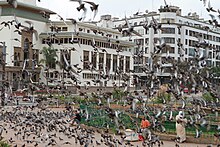Muhammad V Square
Muhammad V Square
ساحة محمد الخامس | |
|---|---|
| Town square | |
| Nickname(s): Pidgeon Square (ساحة الحمام) | |
 Muhammad V Square looking toward the Court of First Instance. |
Muhammad V Square (Arabic: ساحة محمد الخامس), is a public square of historical and symbolic significance located in central Casablanca, Morocco. It was established in 1916 at the beginning of the period of French colonialism—under Resident General Hubert Lyautey—according to the design of the French architects Henri Prost and .[1][2]
Name[]
The square is known officially as Muhammad V Square, in honor of the former king of Morocco Muhammad V. The square is known popularly as "Pigeon Square" (ساحة الحمام) due to the heavy presence of pigeons.[3] It used to be known by different names such as Main Square, Square of France, Square of Victory, Administrative Square, and Lyautey Square.
History[]


The area south of the medina that is now Muhammad V Square had been occupied by barracks of the French colonial troops before the plan of Henri Prost and to establish a large square there was implemented in 1916. It became the heart of the expanding ville européenne, or European city. At the time, it was named Place Lyautey, Lyautey Square, in honor of the France's first résident général in Morocco.

On August 8, 1943, Charles de Gaulle—accompanied by General Georges Catroux, commissary of the Coordination of Muslim Affairs and governor general of Algeria, and Gabriel Puaux, resident general of France in Morocco—appeared at Place Lyautey, where he delivered a speech broadcast by radio.[6][7]
Description[]

Surrounding the square, buildings for important administrative functions were erected in the style innovated by Henri Prost and his contemporaries.[8] This style combined French design principles with traditional Mauro-Andalusi architectural traditions, which lent the colonial administrative buildings legitimacy.
Among the important buildings around the square are:
- The Court House (المحكمة, le tribunal)
- Wilaya Building (مقر الولاية, la siege de la wilaya)
- The Post Office (مكتب البريد, bureau de poste)
- Bank al-Maghreb (بنك المغرب)
Nearby:
- Arab League Park (formerly "Lyautey Park")
- Church of the Sacred Heart
Access[]
The square can be accessed from Muhammad V Square Station (محطة ساحة محمد الخامس, Station Place Mohammed V) on Line 1 of the Casablanca Tramway.
See also[]
References[]
- ^ "Les journées du patrimoine : Circuit Place Mohammed V". 2016-04-02. Archived from the original on 2016-04-02. Retrieved 2019-09-19.
- ^ "ميدان محمد الخامس". www.batuta.com (in Arabic). Retrieved 2019-09-19.
- ^ "ساحة «الحمام» في الدار البيضاء.. مَعْلم تاريخي بتصميم أوروبي | الشرق الأوسط". 2017-05-15. Archived from the original on 2017-05-15. Retrieved 2019-09-19.
- ^ Jump up to: a b Cohen, Jean-Louis (2002). Casablanca : colonial myths and architectural ventures. Monique Eleb. New York. ISBN 1-58093-087-5. OCLC 49225856.
- ^ Jump up to: a b "Histoire du Consulat". Les Consulats Généraux de France au Maroc (in French). Retrieved 2020-03-19.
- ^ "Discours prononcé à Casablanca (Place Lyautey), 8 août 1943" (PDF). charles-de-gaulle.org.
- ^ "Le Petit Marocain". Gallica. 1943-08-08. Retrieved 2020-06-21.
- ^ "Les journées du patrimoine : Circuit Place Mohammed V". 2016-04-02. Archived from the original on 2016-04-02. Retrieved 2019-09-19.
| Wikimedia Commons has media related to Place Mohammed V, Casablanca. |
- Casablanca